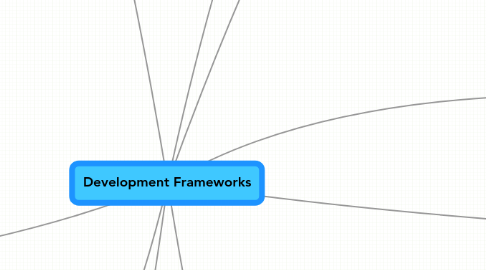
1. Evaluatiing Business Units
1.1. GE Grid
1.1.1. Dimensions
1.1.1.1. Market Attractiveness
1.1.1.2. Competitive Position
1.1.1.3. Business Strength
1.1.1.3.1. Market Size
1.1.1.3.2. Market Share
2. Achieving Growth
2.1. Ansoff Matrix
2.1.1. Dimensions
2.1.1.1. Market
2.1.1.1.1. Existing
2.1.1.1.2. New
2.1.1.2. Product/Brand/Service
2.1.1.2.1. Existing
2.1.1.2.2. New
2.1.1.3. Growth Options
2.1.1.3.1. Organic Growth
2.1.1.3.2. Acquisition
2.1.1.4. Technological Growth
2.1.1.4.1. New Technology
2.1.2. Strategies
2.1.2.1. Market Penetration
2.1.2.2. Product Development
2.1.2.3. Market development
2.1.2.4. diversification
2.2. McKinsey Growth Pyramid
2.2.1. Generic Growth Strategies
2.2.1.1. New Competitive Arenas
2.2.1.2. New Industry Structure
2.2.1.3. New Geographic Areas
2.2.1.4. New Delivery Systems
2.2.1.5. New Products and Services
2.2.1.6. Existing Products to New Customers
2.2.1.7. Existing Products to Existing Customers
2.2.2. Options for Growth
2.2.2.1. Acquisitions
2.2.2.2. Joint Ventures
2.2.2.3. Minority Stakes
2.2.2.4. Alliances
2.2.2.5. Marketing Partnerships
2.2.2.6. Organic Investment
2.2.3. Basis for choice
2.2.3.1. Operaional skills
2.2.3.2. Priveliged assets
2.2.3.3. Growth skills
2.2.3.4. Special relationships
2.3. Growth Vector Analysis
2.3.1. Market Options
2.3.2. Product Alternatives
2.4. Blue Sky Thinking
3. Evaluating the Organisation
3.1. McKinsey Seven S
3.1.1. Hard Ss
3.1.1.1. Strategy
3.1.1.1.1. Plans
3.1.1.1.2. Goals
3.1.1.1.3. Environment
3.1.1.1.4. Competition
3.1.1.1.5. Customers
3.1.1.1.6. Questions
3.1.1.2. Structure
3.1.1.2.1. Organisational
3.1.1.2.2. Relationships
3.1.1.2.3. Power and Control
3.1.1.2.4. Questions
3.1.1.3. Systems
3.1.1.3.1. Procedures
3.1.1.3.2. Processes
3.1.1.3.3. Questions
3.1.2. Soft Ss
3.1.2.1. Shared Values
3.1.2.1.1. Beliefs
3.1.2.1.2. Objectives
3.1.2.1.3. Questions
3.1.2.2. Style
3.1.2.2.1. Behaviours
3.1.2.2.2. Questions
3.1.2.3. Staff
3.1.2.3.1. Functionality
3.1.2.3.2. Education
3.1.2.3.3. Background
3.1.2.3.4. Questions
3.1.2.4. Skills
3.1.2.4.1. Core Competencies
3.1.2.4.2. Questions
3.2. Value Chain
3.2.1. Primary Activities
3.2.1.1. Inbound Logistics
3.2.1.2. Operations
3.2.1.3. Outbound Logistics
3.2.1.4. Marketing and Sales
3.2.1.5. Service
3.2.2. Support Activities
3.2.2.1. Firm Infrastructure
3.2.2.2. HRM
3.2.2.3. Technical Development
3.2.2.4. Procurement
3.3. SWOT
3.3.1. Strengths
3.3.2. Weaknesses
3.3.3. Opportunities
3.3.4. Threats
4. Industry Evaluation
4.1. Five Forces
4.1.1. Factors
4.1.1.1. The risk of new entrants
4.1.1.2. Degree of rivalry among established companies
4.1.1.3. Bargaining power of buyers
4.1.1.4. Bargaining power of suppliers
4.1.1.5. Substitute products
4.1.1.6. Stakeholder forces (optional)
5. Choosing Strategies
5.1. Blue Ocean Strategy
5.1.1. Breakthrough Strategy Canvas
5.1.2. New Value Curve
5.1.2.1. Reduce
5.1.2.2. Create
5.1.2.3. Raise
5.1.2.4. Eliminate
5.2. Competitive Strategy
5.3. Resource Based Strategy
5.4. Competitive Strategy
5.4.1. Customer Value Proposition
5.4.1.1. Choices
5.4.1.1.1. Product Leadership
5.4.1.1.2. Operational Excellence
5.4.1.1.3. Customer Intimacy
5.4.1.2. Hierarchy of Needs
5.4.1.2.1. Product
5.4.1.2.2. Basic Service
5.4.1.2.3. Underlying Problems
5.4.1.2.4. Success
5.4.2. Strategic Positioning
5.4.2.1. Variety Based
5.4.2.2. Needs Based
5.4.2.3. Access Based
5.4.3. Porter's Competitive Advantage
5.4.3.1. Unique activities
5.4.3.2. Activities with Fit
5.4.3.3. Making clear trade-offs and choices
5.4.3.4. Generic Strategies
5.4.3.4.1. Focus
5.4.3.4.2. Differentiation
5.4.3.4.3. Cost Leadership
5.5. What Really Works
5.5.1. Four
5.5.1.1. Strategy
5.5.1.2. Culture
5.5.1.3. Execution
5.5.1.4. Structure
5.5.2. Plus Two
5.5.2.1. Talent
5.5.2.2. Leadership
5.5.2.3. Innovation
5.5.2.4. Mergers and Partnerships
5.6. Resource-Based Strategy
5.7. Disruptive Strategy
5.8. Emergent Strategy
6. Strategic Alignment
6.1. Strategic Statements
6.1.1. Mission
6.1.1.1. Purpose
6.1.1.2. Stakeholder Promises
6.1.1.3. Public Image
6.1.1.4. Standards and Behaviour
6.1.1.5. Values and Beliefs
6.1.1.6. Strategic Distinctiveness
6.1.2. Vision
6.1.2.1. BHAGs
6.1.2.1.1. Core Values
6.1.2.1.2. BHAG
6.1.2.2. Goals
6.1.3. Values
6.1.4. Five Whys
6.1.4.1. Why do we exist?
6.1.4.2. How do we create and capture value?
6.1.4.3. Who are we?
6.1.4.4. What must we do?
6.1.4.5. What is our message?
7. Strategic Learning
7.1. TAIDA
7.1.1. Tracking
7.1.2. Analysing
7.1.3. Imaging
7.1.4. Deciding
7.1.5. Acting
7.2. Action Learning
7.3. Competing on Analytics
7.4. Fifth Discipline
8. Developing Strategies
8.1. Hedgehog Concept
8.1.1. What are you deeply passionate about?
8.1.2. What can you be best in the world at?
8.1.3. What drives your economic engine?
8.2. Integrated Choices
8.2.1. Strategic Frame
8.2.1.1. Tools
8.2.1.1.1. External Analysis
8.2.1.1.2. Internal Analysis
8.2.1.2. Mission/Vision/Values
8.2.1.3. Goals and Objectives
8.2.1.3.1. Quantitative
8.2.1.3.2. Qualitative
8.2.1.4. Organisational Alignment
8.2.1.4.1. People
8.2.1.4.2. Process
8.2.1.4.3. Activities
8.2.1.4.4. Structure
8.2.1.4.5. Rewards
8.2.1.4.6. Policies
8.2.1.5. Firm Performance
8.2.1.5.1. Market
8.2.1.5.2. Financial
8.2.1.5.3. Other
8.2.2. Elements of Strategy
8.2.2.1. Arenas
8.2.2.1.1. Where will we be active and with how much emphasis
8.2.2.1.2. Product Categories
8.2.2.1.3. Market Segments
8.2.2.1.4. Geographies
8.2.2.1.5. Core Technologies
8.2.2.1.6. Value Creation
8.2.2.2. Vehicles
8.2.2.2.1. How will we get there?
8.2.2.2.2. Internal Development
8.2.2.2.3. Joint Ventures
8.2.2.2.4. Licensing/Franchising
8.2.2.2.5. Acquisitions
8.2.2.3. Differentiators
8.2.2.3.1. How will we win?
8.2.2.3.2. Image
8.2.2.3.3. Styling
8.2.2.3.4. Customisation
8.2.2.3.5. Price
8.2.2.4. Staging
8.2.2.4.1. What will be our speed and sequence of moves
8.2.2.4.2. Speed of expansion
8.2.2.4.3. Sequence of initiatives
8.2.2.5. Economic Logic
8.2.2.5.1. How will we obtain our returns?
8.2.2.5.2. Lowest costs
8.2.2.5.3. Premium prices
8.3. WUS
8.3.1. Want
8.3.2. Use
8.3.3. Should
9. Strategy Translation
9.1. RACI Matrix
9.2. Balanced Scorecard
9.2.1. Dimensions
9.2.1.1. Financial
9.2.1.1.1. Growth
9.2.1.1.2. Productivity
9.2.1.2. Customer
9.2.1.2.1. Value Proposition
9.2.1.2.2. Market Choice
9.2.1.3. Internal Process
9.2.1.3.1. Operations Management
9.2.1.3.2. Customer Management
9.2.1.3.3. Innovation Processes
9.2.1.3.4. Societal Processes
9.2.1.4. Learning and Growth
9.2.1.4.1. Human Capital
9.2.1.4.2. Information Capital
9.2.1.4.3. Organisational Capital
9.2.1.5. Public Sector NFP
9.2.1.5.1. Learning and Growth
9.2.1.5.2. Internal Perspective
9.2.1.5.3. Fiduciary Perspective
9.2.1.5.4. Customer Perspective
9.2.2. Indicators
9.2.2.1. Leading
9.2.2.2. Lagging
